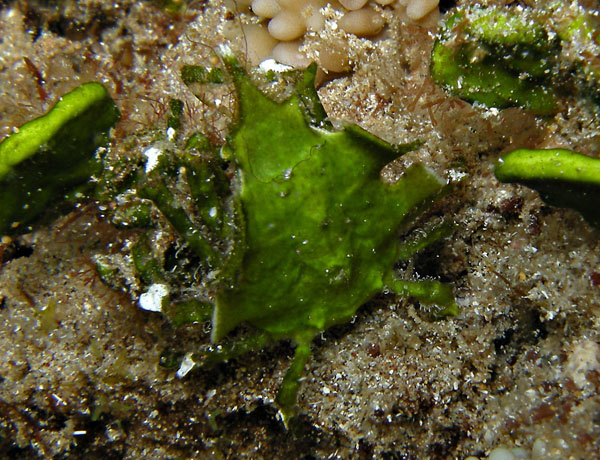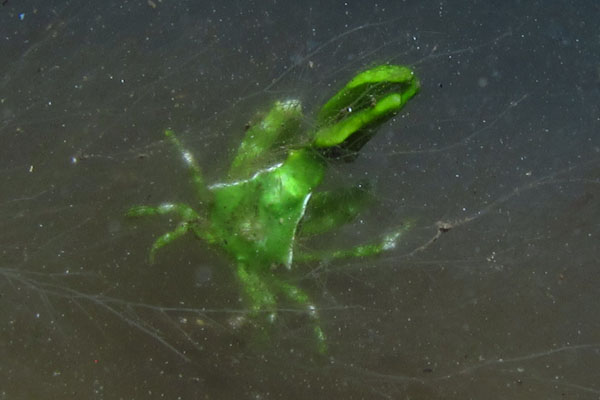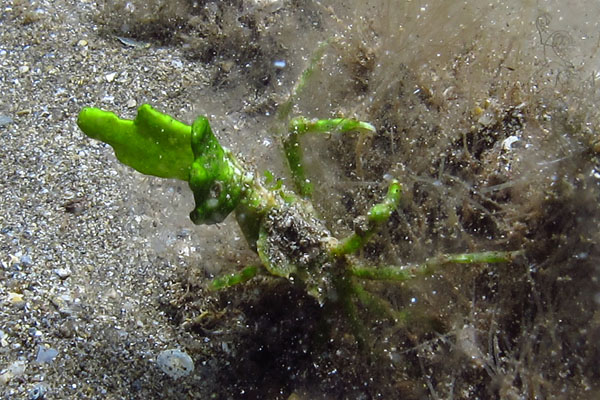|
Some interesting
Hawaiian crabs
including a few not in Hawaii's
Sea Creatures
page
two - crabs
other than xanthids
(page
one, xanthids, is here)
Looking for more crabs? Scott and Jeanette Johnson's Marshall
Islands website is excellent.
Dr. Peter Castro's checklist
of all crabs known from the Hawaiian Islands
(July
2011)
Monographs
by C.H. Edmondson: Hawaiian
Grapsidae Hawaiian
Dromiidae Hawaiian
Portunidae
Hawaiian
Crustacea: Goneplacidae, Pinnotheridae, Cymopoliidae, Ocypodidae, and
Gecarcinidae
Though not 100% accurate,
photos of many of Hawaii's small crabs can be found here
Also check the crab
page of Keoki Stender's Marine Life Photography website.
|

Eric Sanford
|
|
HORN-EYED GHOST
CRAB Ocypode ceratophthalma (Pallas, 1772)
Family Ocypodidae
A mostly nocturnal crab of sandy beaches
named for its remarkable hornlike eyes.. Shelters in a burrow by
day, identified by a conical pile of sand at the entrance. It grows
to about 1.5 inches carapace width and is widespread in the Indo-Pacific.
Eric Sanford took this rare photo. He writes:
"The Horn-Eyed Ghost Crab was photographed at Kahuku Point
on the north shore of O'ahu. Although we saw lots of big holes dug
by this species, we only saw this single crab out foraging. It was
first thing in the morning and the beach was quiet (in terms of
human traffic), so perhaps we got lucky to see this individual out
and about before it retreated to its burrow. But the large burrows
from this crab seemed very common in Hawai'i, so it might be a helpful
addition for readers to see a photo. I was impressed by their eyes
and their speed!"
|
|
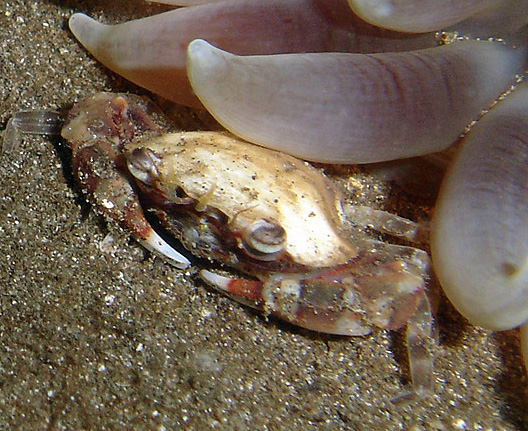
Pauline Fiene
|
|
HARLEQUIN CRAB
Lissocarcinus laevis Miers, 1886
Family Portunidae
Closely related to the common Sea
Cucumber Crab Lissocarcinus orbicularis (p. 275 in my book),
in Hawaii this crab is rarely encountered and seems to lack the
bold "harlequin" pattern typical elsewhere in the Indo-Pacific,
except perhaps on the claw-bearing limbs. It is commensal with large
anemones, including tube anemones. Pauline Fiene photographed this
individual with a Sand Anemone Heteractis malu in Ma`alaea
Bay, Maui (see p. 39 of my book). Athough classified in the swimming
crab family, Portunidae, it probably does not swim much, if at all,
and remains with its host anemone for all its adult life. To about
1.5 inches carapace width. The species is widespread in the Indo-Pacific.
|
|
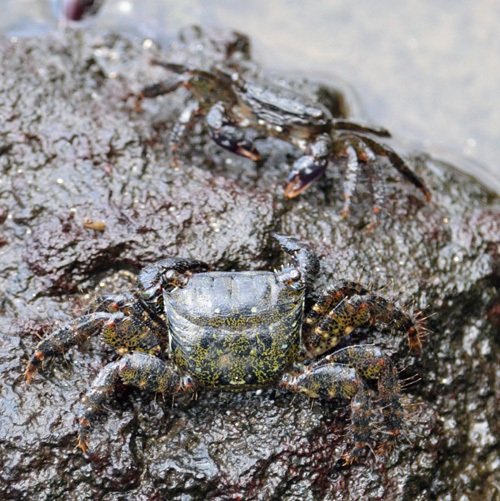
|
|
` ALAMIHI Metopograpsus
thukuhar (Owen, 1839)
Family Grapsidae
Distinctive square carapace with eyes
at the front corners. Common in shallow protected areas clambering
about on exposed rocks at low tide. In other parts of the Indo-Pacific
found principally on mangrove roots. Tolerates brackish water and
can be seen in the mouths of streams. To well over 1 inch in carapace
width. Widely distributed throughout the tropical Indo-Pacific.
M. messor is similar, but restricted to the Western Indian
Ocean.
|
|
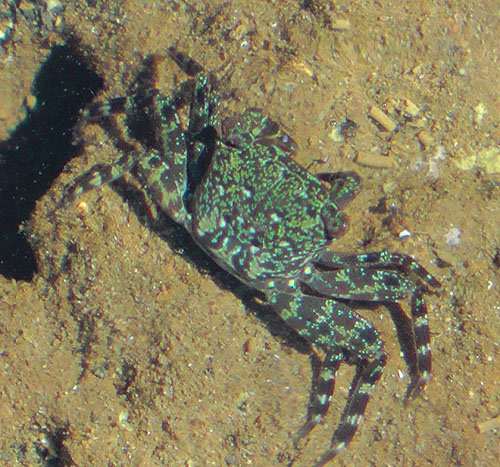
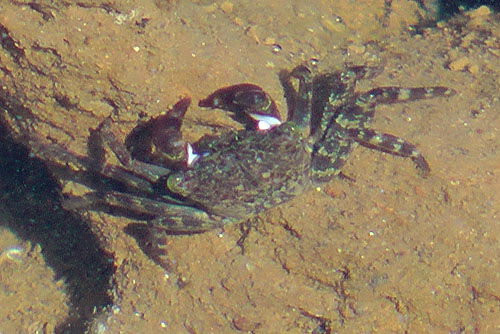
|
|
Pachygrapsus
planifrons DeMan 1888
Family Grapsidae
This is a small crab with a carapace
less than an inch wide that is common in some tide pools. It has
a slightly trapezoidal carapace with eyes at the front corners.
Distinctive white spots on inner sides of claws are revealed when
the crab is feeding, though not all individuals seem to show these
spots. Perhaps they are related to the sex of the animal. Indo-Pacific.
The more common Pachygrapsus plicatus is similar , but has
numerous transverse ridges on carapace. Photos: Punaluu Beach Park,
Hawaii.
|
|
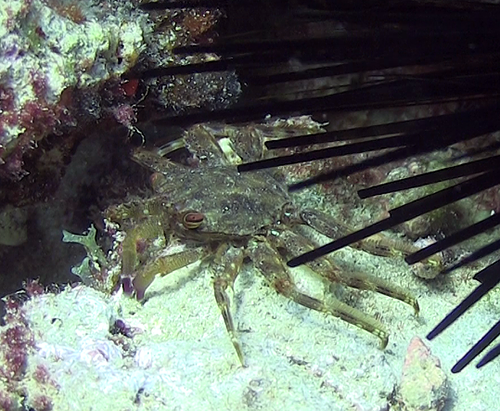
John Earle
|
|
GREEN FLAT ROCK
CRAB Percnon abbreviatum (Dana 1851)
Family Grapsidae
Closely related to the Flat Rock Crab
Percnon planissimum on p 209 of my book, this crab is greenish
with a faint light central stripe running back between the eyes.
The eyes are often reddish and there are often some indistinct yellow
spots on the legs. Crabs of this genus often have red or purplish
claw tips, faintly visible here. This is a still from video shot
by John Earle off Oahu. To about 1 inch carapace width. The species
is widespread in the Indo-Pacific. Identification tentative.
|
|
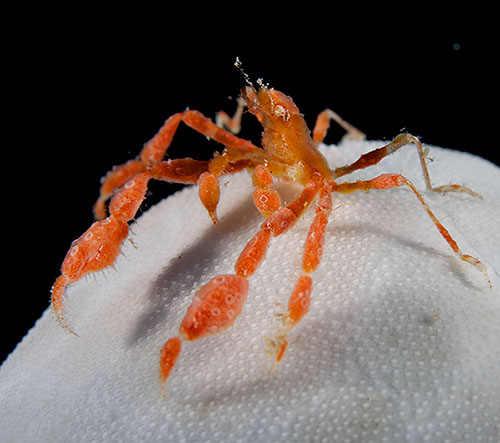
Paul Okumura
|
|
Spider crab
in the genus Oncinopus.
Family
Inachidae
Paul Okumura of Kona Diving
Company photographed this unusual little crab at a depth of about
40 ft. at "Rabbi's Reef" a site off the Kona Coast of
Hawaii Island. Paul reports that he found it in rubble and that
it was about 1 inch across. I sent the photo Dr. Peter Ng of the
National University of Singapore who identified it as a spider crab
in the genus Oncinopus. Two species of Oncinopus are
known in Hawaii--O.araneus and O. neptunus-- but without
the actual crab in hand he could not determine which one it is.
|
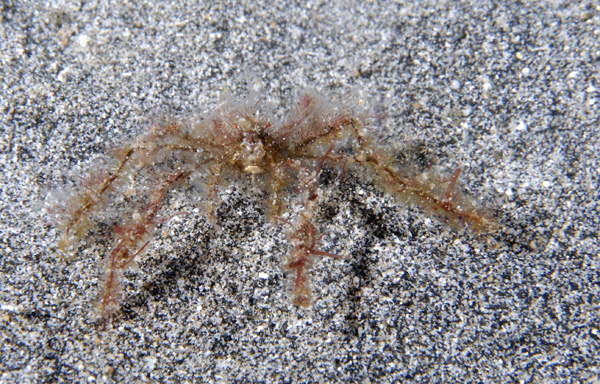 |
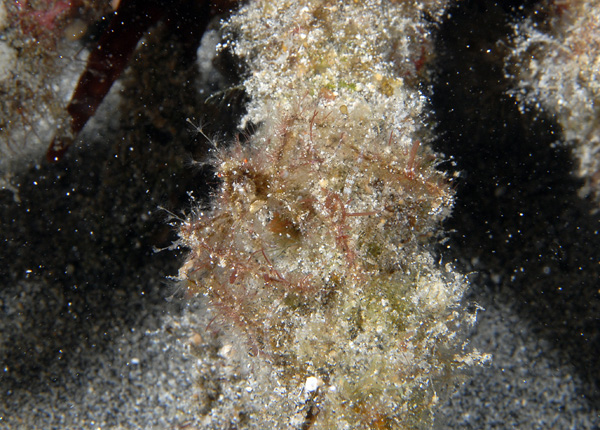 |
|
Achaeus japonicus?
Family
Inachidae
I found this crab on a thick-spined
Chondrocidaris gigantea urchin at Ho'okena, Hawai'i at a
depth of about 30 ft. The urchin was out in the sand away from the
reef, which not its normal habitat. Dr. Peter Ng of the National
University of Singapore tentatively identified the crab as a member
of the genus Achaeus, possibly A. japonicus, although
that species has not been recorded from Hawaii. I temporarily placed
the crab on the sand for a photo (top). The lower photo shows it
on one of the urchin's thick spines, which, as usual with these
urchins, was covered with growths.
=================================================================
|
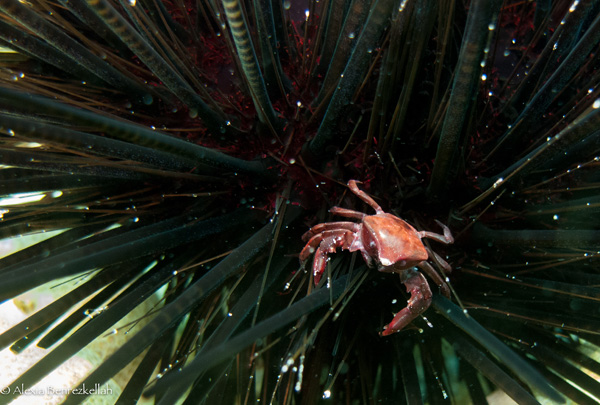 |
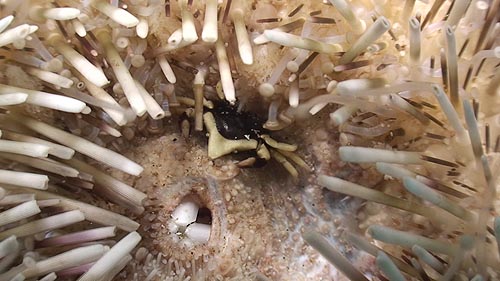 |
|
SEA URCHIN CRAB
Echinoecus pentagonus (A. Milne Edwards, 1879)
Family
Pilumnidae
Although this crab is in my
book on p. 270, the photo does not show the whole animal. Here are
some additional pictures. This crab is a common parasite of the
Banded Sea Urchin Echinothrix calamaris. Large mature females
inhabit the urchin's rectum (on the upper part of the urchin) where
they remain imprisoned, while males and small females roam the surface
of the urchin. At top is a free-roaming male or small female on
a Banded Urchin, as photographed by Alexia Benrezkellah. Dr. Peter
Castro reports that while juveniles may occasionally settle on urchin
species other than the Banded Urchin, the rectums of these other
urchins are too small to house a mature female. The
lower photo by John Earle shows a male or small female on a Pebble
Collector Urchin Pseudoboletia indiana.
Rare observation of Dwarf Moray, Gymnothorax melatremus preying
on E. pentagonus:
On 01-26-2016 Alexia Benrezkellah wrote: "While on a dive ...
this morning I saw one of the coolest things I've seen underwater.
A dwarf moray rammed its head into the hole of an urchin and ripped
out the crab and swallowed it whole. Unfortunately ... no photos."
|
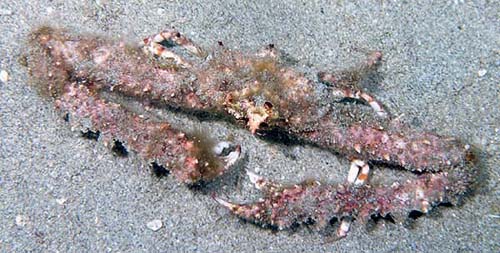 |
|
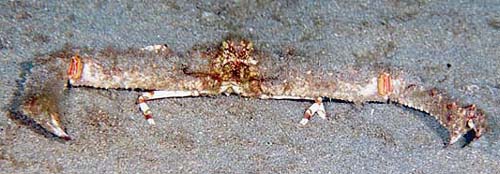
|
|
GIANT ELBOW
CRAB
Rhinolambrus contrarius (?)
Family Parthenopidae
John Earle spotted this amazing animal
sitting motionless in silty sand at a depth of about 60 ft. off
Kahe Point, O`ahu. He called me over then touched it lightly with
his wand whereupon it spread its arms menacingly in a span of at
least 12 in. Having never seen anything like it before, I decided
to collect it in case it was a species not known in Hawai`i. Picking
it up was easy but holding it for any length of time was not; it
seemed to be able to reach me with its pincers no matter where I
grasped it. Eventually we got it into a bag, and, once ashore, into
a bucket.
When I got home I put an airstone in the
bucket and started looking in books to see what it might be. Clearly,
it belonged to the crab family Parthenopidae, commonly known as
"elbow crabs." A 1965 book (long out of print) by Spencer
Wilkie Tinker got me pretty close to the answer. The book is titled
"Pacific Crustacea, an Illustrated Handbook of the Reef-Dwelling
Crustacea of Hawaii and the South Seas" and on p. 88 it shows
a photo of the crab, or something very much like it, under the name
Lambrus (Rhinolambrus) longispinis. Tinker called it the
Long-Spined Parthenopid Crab. Of it he says:
"The carapace of shell of this crab
is covered with tubercles and short spines. The front legs or chelipeds
are large and are also covered with tubercles and spines, of which
those along the angles of these legs are triangular in shape. The
walking legs are slender, quite smooth, and marked with encircling
bands of color. The carapace measures about two inches in width.
This is an Indo-Pacific species which extends from Hawaii southward
to Australia, westward to Japan, through the East Indies, and across
the Indian Ocean to the coast of Africa.
This rare crab has been retrieved
from rocky bottoms at depths of about one hundred feet."
I took photos
of the crab and sent them to the world's expert on parthenopids,
Dr. Swee Hee Tan of the National University of Singapore. However,
it was the weekend and I didn't expect Dr. Tan to answer for a couple
of days. Since the crab was in Tinker's book I figured it there
was no reason to keep it, so the following day John Earle and I
returned it to the spot where we had captured it.
Soon afterwards I got an answer from Dr.
Tan. He thought it looked like Rhinolambrus contrarius but
of course couldn't be sure without a specimen. I notified Dr. Peter
Castro, who is working on crabs at the Bishop Museum; he said that
Rhinolambrus contrarius is not presently known from the Hawaiian
Islands. So, it looks like it's at least possible that it's a different
species than the one pictured in Tinker's book, which, come to think
of it, did seem to have thicker chelae (pincers). Also, Tinker's
animal came from rocky bottom whereas this crab was in soft silty
sand and nowhere near rocks. On the other hand, Tinker's description
of the banded legs was perfect. So in the end we don't know what
it is. It could well be a new record for Hawai`i but we won't know
until another is found and collected as a specimen. I have here
proposed the common name Giant Elbow Crab, just in case it is not
the same as Tinker's animal. Dr. Tan, however, says that in terms
of leg span there are probably larger elbow crab species in Japan
and the Mediterranean.
July 15, 2007
update: Kent Backman writes from Kaua`i:
I
saw a odd looking horned helmet in the sand at 130 ft, which turned
out to be odd because it was (temporarily?) cohabitating with this
strange looking crab. With its two large arms folded, it was about
the breadth of the horned helmet…14 inches or so. But when
I approached with my video camera to get a macro shot, the arms
popped out and it attacked in a very quick defensive maneuver.
I
am quite positive I have not seen this guy before. I would have
liked to collect it, but my hour+ deco in ripping current was hard
enough as it was. I would have had to somehow kill that crab in
order to bring it up safely. He was very defensive!.
Here
is a link to my video, alas with only visible light…not so
good at 130 ft.
http://www.veoh.com/videos/v1159909rJCYf7tD
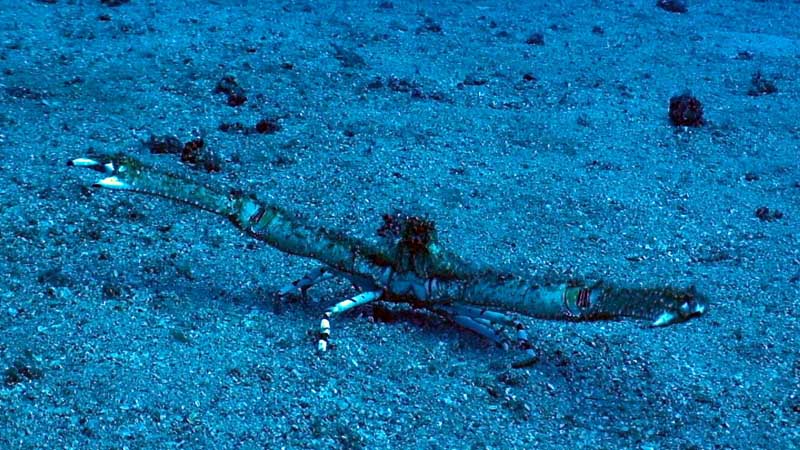
|
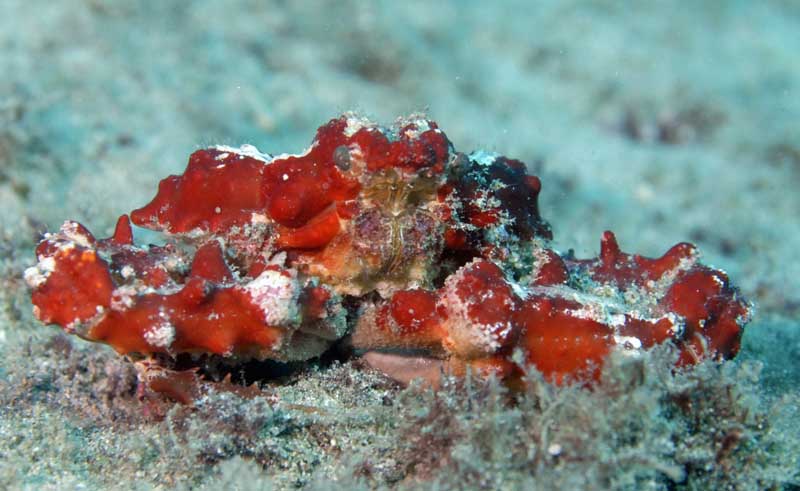 |
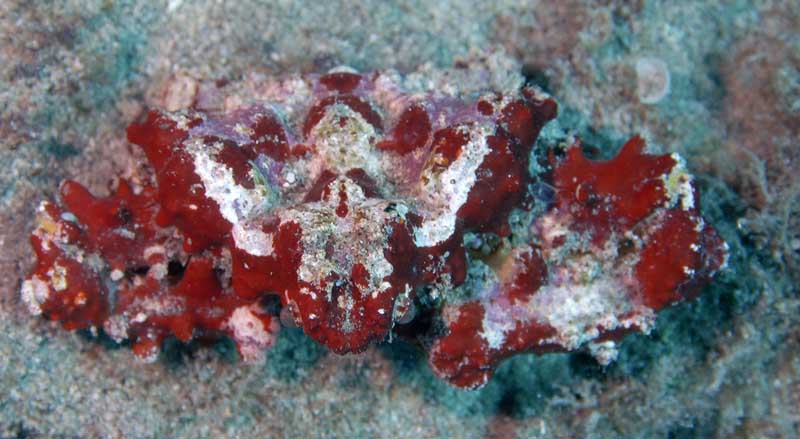 |
|
KING KONG CRAB
Daldorfia rathbunae (De Man, 1902)
Family
Parthenopidae
I photographed this crab at Makua,
Oahu, in about 30 ft. In the original ed. of Hawaii's Sea Creatures
I showed a similar but smaller crab which I erroneously called the
Horrid Elbow Crab with the scientific name Daldorfia horrida,
but it has turned out to be the recently-named Daldorfia dimorpha
(Tan & Ng, 2007). In the revised edition I kept the photo but
called it "Holcom's Elbow Crab" (Daldorfia sp.)
after diver Ron Holcom, who collected the animal and showed it to
me. However, Tinker's 1965 book "Pacific Crustacea..."
lists Daldorfia horrida as occurring in Hawaii and mentions
that it grows to a width of 4 in. I suspect the crab above is the
same species that Tinker shows in his book. He calls it the "Horrid
Parthenopid Crab" and writes:
Like
most parthenopid crabs, the surface of this species is rough. It
is covered with rough elevations and depressions and with smaller
tubercles and pits. The chelipeds (claws) are usually unequal in
size, and the walking legs bear spines which grow in such a way
that they form a perforated margin along the upper edge of the leg.
The carapace is somewhat five-sided and is four inches in width.
This
crab is an Indo-Pacific species... (and) is reported to live on
bottoms of mud or broken shells from shallow water to depths in
excess of three hundred feet.
However, Dr.
Swee Hee Tan of the National University of Singapore says that as
far as he knows the true D. horrida does not occur in Hawai`i
and the crab which Tinker illustrates and describes is actually
D. rathbunae.
Below is another
photo, taken by John Earle at Makua, Oahu at a depth of 40 ft.
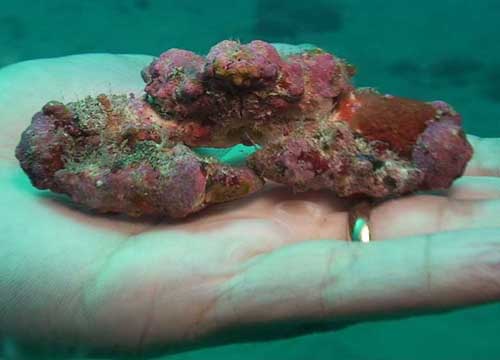
|
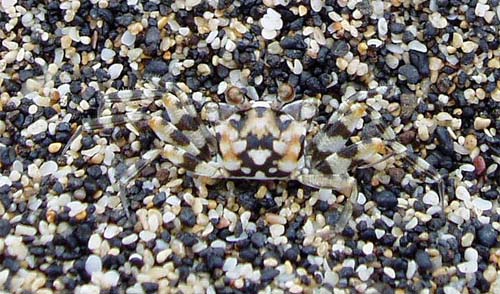 |
|
Ghost Crab juvenile
Ocypode sp.
Ray
Farm took this wonderful picture of a small crab on a beach near
Honokohau Harbor, on the Kona Coast of the Big Island; Dr. Peter
Ng of the National University of Singapore identified it as a small
ghost crab. Two species of ghost crabs are known in Hawai`i but
it's not clear which one this represents. Ray writes: "It is
a very small crab (less than 1 inch across including the legs) with
some of the most amazing camouflage that I have ever seen. I'm not
sure whether it truly matches the mixture of white, black, and beige
sand particles or if it is somewhat transparent and you actually
see the sand particles through the body and legs. Whatever the case,
nature certainly is protecting the little guy from predators. We
could see him when he moved, but he disappeared when he stopped.
I just took a picture of the area where I thought he had stopped
and found him in the picture."
|
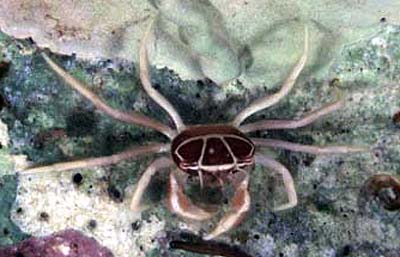 |
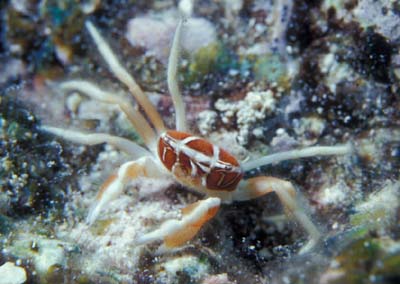 |
|
Viaderiana
taeniola
(Rathbun, 1906)
family Pilumnidae
top photo: J.Hoover Wai`anae, O`ahu. 100 ft.
bottom photo: Tina Owens, Kona, Hawai`i.
|
 |
|
Nucia speciosa
Dana 1852
family Leucosiidae
O`ahu. collected by Darrell Takaoka
|
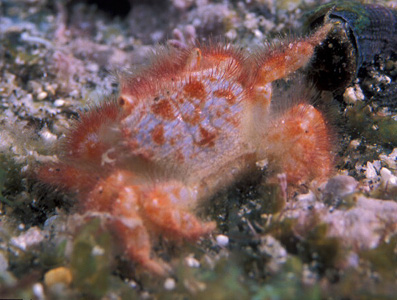 |
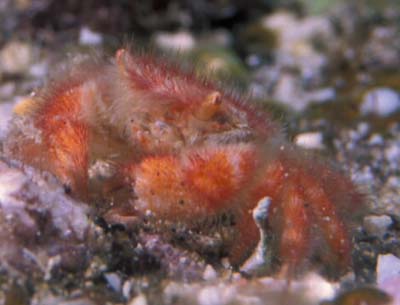 |
|
Crinitocinus alcocki
(Borradaile, 1900)
family Goneplacidae
About 9-10 years ago Tina Owens sent me these crab photos which
she took in Kona, Hawai`i. Tina called it the "Crusader Crab"
because of the red cross on its back. I sent the photos to Dr. Peter
Ng in Singapore who replied. "Your crusader crab is interesting!!!
It may well be a rather rare animal called Parapilumnus."
Peter has a long memory. In Dec. 2013 he wrote: "Finishing
up loose ends all over …. Had this old picture sent by you.
It was an unidentified crab which I said may be Parapilumnus …
was from a lady called "Tina" I know what it is now ….
A new genus allied to Parapilumnus which I calling Crinitocinus
…. Species is Crinitocinus alcocki (Borradaile, 1900)."
|
|




